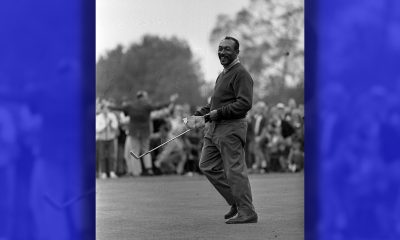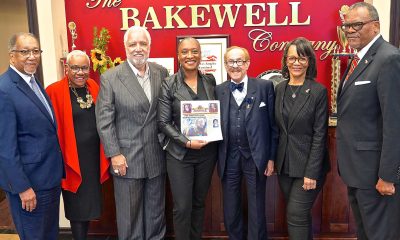Black History
Black history tour focuses on history, wellness and walking
LOUISIANA WEEKLY — On March 14, in honor of Black History Month, health benefits company Aetna sponsored a historic walking tour for older adults. The tour started at the Treme Recreation Center and progressed to Congo Square. Aetna arranged the tour in order to not only educate residents about the history of the city and its vibrant Black music culture, but to also provide older adults with an activity that keeps them physically active.
By Victoria Clark
Black history was on full display as New Orleans residents set out on a historic walking tour to learn more about the city, its history and culture, last week.
On March 14, in honor of Black History Month, health benefits company Aetna sponsored a historic walking tour for older adults. The tour started at the Treme Recreation Center and progressed to Congo Square. Aetna arranged the tour in order to not only educate residents about the history of the city and its vibrant Black music culture, but to also provide older adults with an activity that keeps them physically active.
The tour was originally scheduled for Feb. 28 but had to be rescheduled due to weather concerns.
Aetna wanted the opportunity to be a chance for individuals to learn about their ancestors’ unique history in a celebratory, dignified way while providing a healing cathartic experience.
The culture of New Orleans is strongly impacted by Congo Square because of the history of music, dance, and the overall arts of the enslaved Africans brought to America. Congo Square was a safe space for those enslaved to practice their rituals, religions, traditions and ways of life from their homelands on Sundays. Participants said that learning about Congo Square would allow them to be educated on less popular parts of New Orleans.
“Being that I’m from New Orleans, learning about the actual historical background of Congo Square would be getting complete knowledge of the New Orleans culture,” Klervae Stinson, a NORD commission cultural programs assistant said.
From being enslaved to eventually gaining their freedom, Black people transformed the sounds from their ancestors into negro spirituals, jazz, blues and rock and roll throughout the years. As Congo Square became the birthplace for these genres, New Orleans became known as a city that allows you to express yourself freely with the art of music. Statues of musical giants like Louis Armstrong, Mahalia Jackson and Buddy Bolden are in Congo Square to honor the musical legends.
Throughout the tour, tour guides Sakura Konē, and Mikhala Iverson, explained that Congo Square was not only a place of music, but a place that helped shape the history of New Orleans and branded the city as a whole.
During the Jim Crow era, Black musicians had very few ways to enjoy their music as their own. Iverson explained that famous musicians like Buddy Bolden, a cornetist, would guard his hand while playing his instrument and never recorded his music. He did this because of the possibility of his music being stolen. Music was considered sacred. Iverson who is a jazz singer as well as a tour guide, explained that the same tradition is still practiced in New Orleans because it is a part of the culture.
“I was taught if we write it down, then the white man will take it and make it his,” she said.
The park does more than just honor the music of the New Orleans area. It also gives insight to the traditions of New Orleans like the Black Indians, Super Sunday and second lines. It includes statues of famous Black Indians like Allison “Tootie” Montana to show how the history of Africans has transformed and molded New Orleans from the past until now. Konē explained that Native Americans and Africans became allies during times when slavery was prominent, which would eventually form a relationship that created the modern-day Black Indians.
“In honor of their unity of the Black people and the Red people, the indigenous and the African, Black Indians would hand sew elaborate and colorful suits for 365 days,” Konē explained.
Iverson explained that Mardi Gras as a celebration was started by a group called the Anglo Saxon. They wanted to celebrate Mardi Gras to show wealth.
“The reason they started Mardi Gras in New Orleans was to mock the royalty of Europe here,” Iverson said.
Congo Square is a space to remember those that made New Orleans what it is known for today. It celebrates not only the negative side of Black history, but it also shows how Africans experienced positivity in history which eventually branded an entire city.
“Everyone should always know their past to be able handle their present and future,” said Stinson.
Konē explained that Congo Square’s history continues to be added to today by active citizens celebrating through music every Sunday.
“On Sunday’s they still celebrate the culture till this day. Just follow the drums,” he said.
This article originally appeared in the Louisiana Weekly.
Activism
Oakland Post: Week of April 24 – 30, 2024
The printed Weekly Edition of the Oakland Post: Week of April 24 – 30, 2024

To enlarge your view of this issue, use the slider, magnifying glass icon or full page icon in the lower right corner of the browser window. ![]()
Activism
Oakland Post: Week of April 17 – 23, 2024
The printed Weekly Edition of the Oakland Post: Week of April 17 – 23, 2024

To enlarge your view of this issue, use the slider, magnifying glass icon or full page icon in the lower right corner of the browser window. ![]()
Black History
Matthew Henson: Explorer Extraordinaire
Matthew Henson, a trailblazing explorer who overcame countless obstacles to leave an incredible mark on history. Born on August 8, 1866, in Charles County, Maryland, his journey is a testament to the power of determination and the spirit of adventure.

By Tamara Shiloh
Matthew Henson, a trailblazing explorer who overcame countless obstacles to leave an incredible mark on history. Born on August 8, 1866, in Charles County, Maryland, his journey is a testament to the power of determination and the spirit of adventure.
Henson’s life began amidst the backdrop of post-Civil War America, where opportunities for African Americans were scarce. From a young age, he possessed an insatiable curiosity about the world beyond his small town. At the age of 12, he embarked on a journey that would change the course of his life forever when he joined a merchant ship as a cabin boy.
His most famous expedition was his journey to the Arctic with renowned explorer Robert E. Peary. In 1887, Henson joined Peary’s crew as a seaman and quickly proved himself to be invaluable with his skills as a navigator and craftsman. Over the course of several expeditions, Matthew endured extreme cold, treacherous terrain, and grueling conditions as he and Peary sought to reach the elusive North Pole.
In 1908–09, Peary set out on his eighth attempt to reach the North Pole. It was a big expedition, with Peary planning to leave supplies along the way. When he and Henson boarded their ship, the Roosevelt, leaving Greenland on August 18, 1909, they were joined by a large group. This included 22 Inuit men, 17 Inuit women, 10 children, 246 dogs, 70 tons of whale meat, blubber from 50 walruses, hunting gear, and tons of coal.
In February, Henson and Peary left their anchored ship at Ellesmere Island’s Cape Sheridan, along with the Inuit men and 130 dogs. They worked together to set up a trail and supplies along the way to the Pole.
Peary picked Henson and four Inuit people to join him in the final push to the Pole. However, before they reached their destination, Peary couldn’t walk anymore and had to ride in a dog sled. He sent Henson ahead to scout the way. In a later interview with a newspaper, Henson recalled being in the lead and realizing they had gone too far. The group turned back, and Henson noticed his footprints helped guide them to their destination. At that location, Henson planted the American flag.
Henson’s legacy extends far beyond his expeditions to the Arctic. He shattered racial barriers in the world of exploration and inspired countless individuals, regardless of race, to dream big and pursue their passions. In 1937, he was finally recognized for his achievements when he was inducted into The Explorers Club, an organization dedicated to promoting scientific exploration and field research.
Matthew Henson died in the Bronx, New York, on March 9, 1955, at the age of 88.
-

 Community2 weeks ago
Community2 weeks agoFinancial Assistance Bill for Descendants of Enslaved Persons to Help Them Purchase, Own, or Maintain a Home
-

 Activism3 weeks ago
Activism3 weeks agoOakland Post: Week of April 3 – 6, 2024
-

 Business2 weeks ago
Business2 weeks agoV.P. Kamala Harris: Americans With Criminal Records Will Soon Be Eligible for SBA Loans
-

 Activism2 weeks ago
Activism2 weeks agoOakland Post: Week of April 10 – 16, 2024
-

 Community2 weeks ago
Community2 weeks agoAG Bonta Says Oakland School Leaders Should Comply with State Laws to Avoid ‘Disparate Harm’ When Closing or Merging Schools
-

 Community1 week ago
Community1 week agoOakland WNBA Player to be Inducted Into Hall of Fame
-

 Community2 weeks ago
Community2 weeks agoThe Year Ahead: Assembly Speaker Rivas Discusses Priorities, Problems
-

 Community1 week ago
Community1 week agoRichmond Nonprofit Helps Ex-Felons Get Back on Their Feet

























































1 Comment